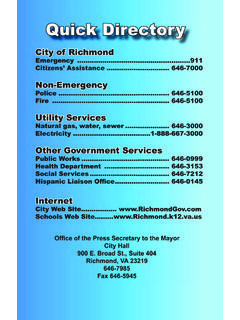Transcription of AA CCiittiizzeenn''ss GGuuiiddee ttoo ...
1 AA CCiittiizzeenn''ss GGuuiiddee ttoo PPaarrttiicciippaattiioonn iinn tthhee LLeeggiissllaattiivvee PPrroocceessss Prepared by the House Majority Staff Office Hawaii State House of Representatives with contributions from the Senate Majority Research Office Hawaii State Senate June 2013 T A B L E O F C O N T E N T S Preface .. i How a House Bill Becomes Law .. 1 Bills and Resolutions .. 2 Bills .. 2 Resolutions .. 3 The Legislative Timetables and the Legislative Process .. 4 Opening Day .. 4 Bill Introduction; Bill Introduction Cutoff Deadline .. 5 First Lateral Deadline .. 5 Mandatory Five-Day Recess .. 6 First Decking Deadline .. 6 First Crossover Deadline .. 6 Second Lateral Deadline .. 6 Second Decking Deadline .. 7 Second Crossover Deadline .. 7 Disagree .. 7 First Crossover: Concurrent Resolutions .. 7 Final Decking Deadline .. 8 Adjournment Sine Die .. 8 Committee Testimony .. 9 Written Testimony Outline.
2 11 Sample Written Testimony .. 12 Membership, Leadership and Standing Committees .. 13 Membership .. 13 Leadership .. 13 Standing Committees .. 13 Legislative Resources .. 15 Citizen Participation Factsheet .. 19 When does the Legislature convene in regular session? And how long is a legislative session? .. 19 When does each house of the Legislature meet in floor session? .. 19 When do the standing committees of the House and Senate meet? .. 19 Can I use the internet to retrieve the text of bills and other documents electronically? .. 19 How can I get on a committee's e-mail, mailing, or fax list? .. 20 Where do I obtain copies of bills and resolutions if I do not have internet access? Is there a charge for copies? .. 20 How can I get information on the status of a bill or resolution? .. 21 How do I submit testimony for a public hearing? .. 21 While I am at the State Capitol, are there any work areas available for me to use to prepare testimony or to organize my materials?
3 22 Are there any services for the physically challenged during public hearings of the Legislature? .. 22 Where can I park when I want to visit the Capitol? .. 23 PREFACE Your participation in the legislative process is essential to the preservation of democracy. You really can make a difference! A Citizen's guide to Participation in the Legislative Process contains an overview of the legislative process, testimony guidelines, committee information, and resource center information. Additional information, including committee membership, hearing schedules, legislators' contact information, and State Capitol maps is available through links to the public websites of the Hawaii State Legislature and the Hawaii Public Access Room found throughout this guide . A helpful glossary of frequently-used terms that may be helpful to understanding the legislative process and this guide is available on the Hawaii State Legislature's website.
4 I * Senate bills go through the same process, starting with bill introduction in the Senate. 1 3rd Reading Bill Introduced 1st Reading Referred to Committees Committee Hearing & Committee Report 2nd Reading Committee Hearing & Committee Report Bill Sent to Non-Originating Chamber 1st Reading Referred to Committees Committee Hearing & Committee Report 2nd Reading Committee Hearing & Committee Report 3rd Reading Non-Originating Chamber Amends House Bill Originating Chamber Agrees With Changes to Bill Originating Chamber Disagrees With Changes to Bill Referred to Conference Committee Conference Committee Meetings & Conference Report Bill Passes Final Reading in Both Houses Bill Passes Final Reading in Originating Chamber Non-Originating Chamber Passes Bill Without Amendments Bill Certified & Sent to Governor HOW A HOUSE BILL BECOMES LAW* 2 BILLS AND RESOLUTIONS Bills The Hawaii State Constitution requires that every law enacted by the Legislature be introduced in the form of a bill.
5 The bill title must encompass the entire subject matter of the bill and each bill can encompass only one subject. Bills are the most important of all vehicles available to the Legislature because, if passed, bills have the force and effect of law. Some of the major functions of a bill include: Amending the Hawaii Revised Statutes (HRS) by adding a new law, or amending or deleting an existing law. Note that as a general rule, laws that are of a "general and permanent nature" are codified into the HRS. Amending the Session Laws of Hawaii (SLH) by adding a new law, or amending or deleting an existing law. Note that the SLH is an annual compilation of all laws enacted by the Legislature each session, including laws amending the HRS and those that are not codified in the HRS. Laws in the latter category include laws that appropriate funds, authorize the issuance of bonds, and establish temporary commissions.
6 Proposing amendments to the Hawaii State Constitution. The Hawaii State Constitution sets forth the basic principles and laws of the State that determine the powers and duties of government and guarantee certain rights to the people. The Legislature may propose a change to the Hawaii State Constitution by adopting a bill containing the proposed amendments. Proposed amendments are then submitted to the electorate for approval or disapproval at the next general election. Short-form Bills. Most bills are introduced in a form that contains the necessary details to accomplish the bill's purposes. A short-form bill is introduced with only a reference to a general idea, which is expressed in its title. A committee to which a short form bill has been referred may fill in the details of the general idea by inserting substantive provisions into the bill. However, timely notice of decision making to insert the substantive provisions must be given and all amendments made to the bill must thereafter be affirmed by committee vote.
7 The amended bill must then be recommitted to the committee by a floor vote for purposes of holding a public hearing on the contents inserted. Companion Bills. Companion bills are identical versions of the same bill that are introduced in both the House and the Senate to increase the chance of passage. 3 Administration Bills. Administration bills are prepared and proposed by executive branch agencies for consideration by the Legislature. Carryover Bills. The Hawaii State Constitution provides that any bill pending at the adjournment of a regular session in an odd-numbered year will automatically carry over with the same bill number and status for consideration in the next regular session. Resolutions There are two types of resolutions concurrent resolutions and single-house resolutions. A concurrent resolution expresses the position of both houses of the Legislature or requests action on behalf of both houses of the Legislature; therefore it must be adopted by both houses of the Legislature.
8 A single-house resolution expresses the position of the house in which it was introduced or requests action on behalf of the house in which it was introduced; therefore it need only be adopted by the house in which it was introduced. Unlike enacted bills, adopted resolutions do not have the force and effect of law. Therefore, many of them request or urge action, rather than require action. For example, a resolution may request an agency to study a proposal or problem and report back to the Legislature or may urge action by the President of the United States, Hawaii's congressional delegation, the Governor, or officials or agencies of other government jurisdictions. For some actions, the adoption of a concurrent resolution is required by law. For example, authorization of the Legislature by concurrent resolution is required to approve a development project under Section 171-60, Hawaii Revised Statutes, or to lease state submerged lands and lands beneath tidal waters under Section 171-53, Hawaii Revised Statutes.
9 Although resolutions may be adopted immediately upon introduction, they are typically referred to a committee, whereupon they proceed through the legislative process in a manner similar to bills. The legislative timetable sets forth milestones and deadlines applicable to concurrent resolutions. 4 THE LEGISLATIVE TIMETABLES AND THE LEGISLATIVE PROCESS This overview of the legislative timetables and legislative process is meant to give you a general idea of the Legislature's work schedule throughout the legislative session. The legislative timetable sets forth, among other things, the milestones and filing and voting deadlines that different types of legislative measures must meet to progress successfully through the legislative process. It is customarily a two-page document with information presented in calendar form on the first page and in a more detailed list form on the second page. Measures can die if they fail to meet the milestones and deadlines established by the legislative timetable, so familiarity with the timetable is of critical importance.
10 Keep in mind that deadlines set by the timetable represent the last day upon which an action must occur; accordingly, a measure can proceed through the legislative process at a much quicker pace ahead of these milestones and deadlines. In addition to the legislative timetable, each house has an internal legislative timetable that sets forth additional requirements established by each house, such as limits on the number of bills that may be introduced and the triple referral filing deadline which applies to bills that are referred to three or more successive committees. A new legislative timetable is established for each annual regular session by agreement between the Speaker of the House and the President of the Senate. A new internal legislative timetable is adopted by each house for each annual regular session. Make sure the timetables you rely on are current. The current legislative timetable may be accessed on the Hawaii State Legislature's website by following the "Calendar" link on the home page and clicking on the button marked "Printable PDF version" at the top of the page.










